Management and Organizations in Global Environment - Report Analysis
VerifiedAdded on 2020/03/02
|10
|1381
|50
Report
AI Summary
This report delves into the application of Taylorism in contemporary organizations, examining its modifications and integration with modern business theories. It explores the relevance of Taylorism in today's world, highlighting its continued use in specific sectors like call centers and fast-food chains, particularly in regions like India and Dubai. The report further investigates the relationship between organizational structure and strategy, emphasizing how structure influences the adoption of strategies and how leadership must align these elements for optimal performance. It discusses the importance of employee valuation, the impact of bureaucracy, and the need for effective strategy implementation to achieve a competitive advantage in the ever-changing technological and economic landscape. The analysis underscores the necessity of combining strategies and structure to meet organizational goals effectively.
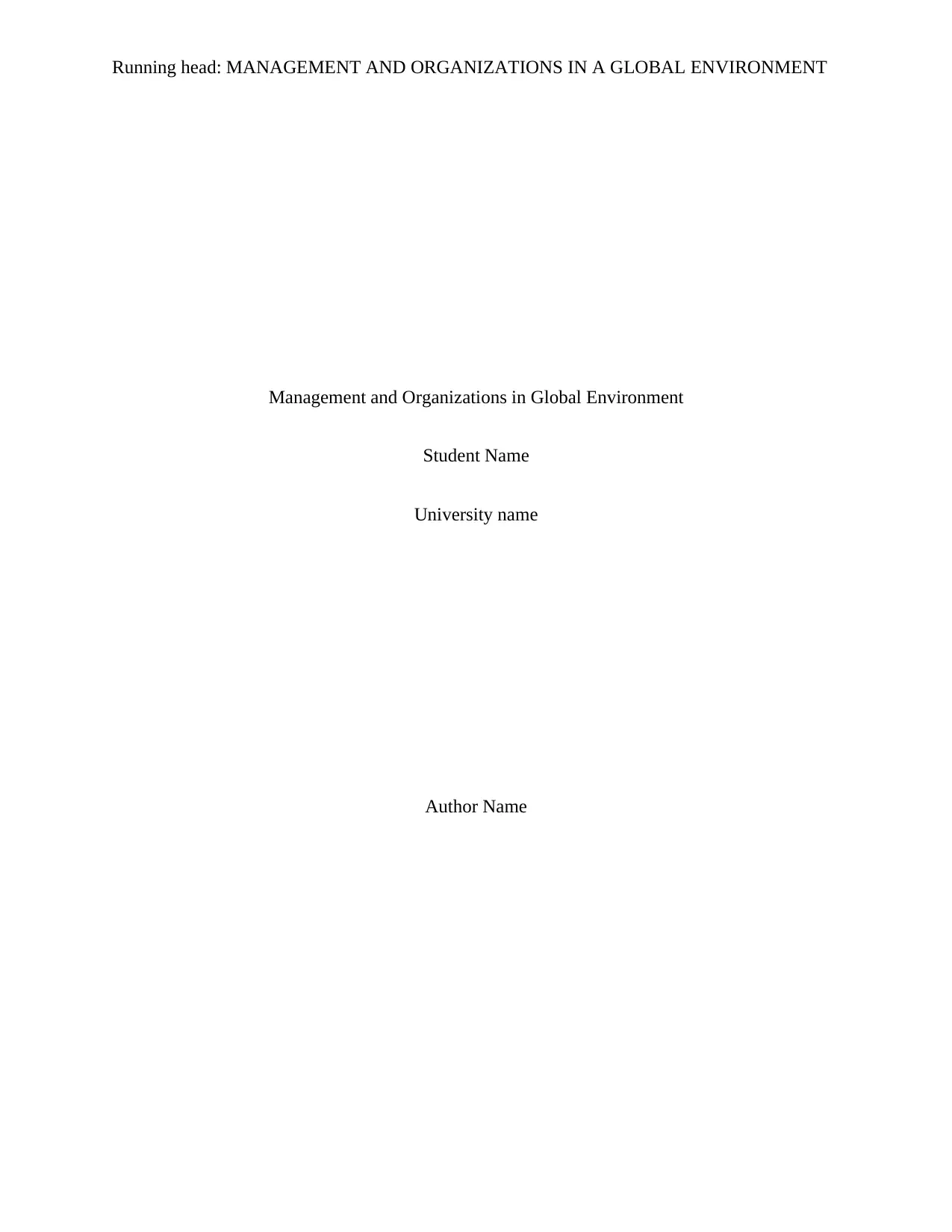
Running head: MANAGEMENT AND ORGANIZATIONS IN A GLOBAL ENVIRONMENT
Management and Organizations in Global Environment
Student Name
University name
Author Name
Management and Organizations in Global Environment
Student Name
University name
Author Name
Paraphrase This Document
Need a fresh take? Get an instant paraphrase of this document with our AI Paraphraser
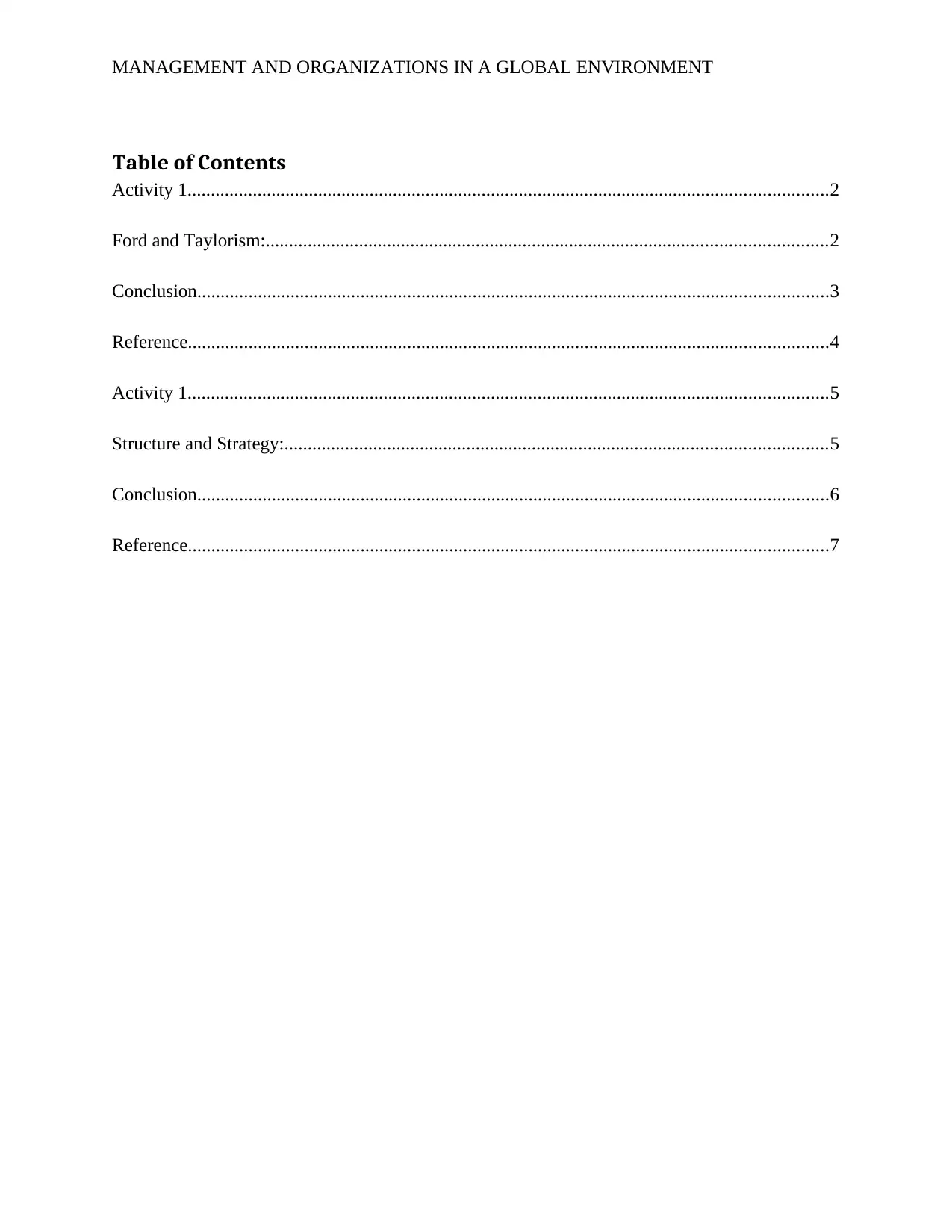
MANAGEMENT AND ORGANIZATIONS IN A GLOBAL ENVIRONMENT
Table of Contents
Activity 1.........................................................................................................................................2
Ford and Taylorism:........................................................................................................................2
Conclusion.......................................................................................................................................3
Reference.........................................................................................................................................4
Activity 1.........................................................................................................................................5
Structure and Strategy:....................................................................................................................5
Conclusion.......................................................................................................................................6
Reference.........................................................................................................................................7
Table of Contents
Activity 1.........................................................................................................................................2
Ford and Taylorism:........................................................................................................................2
Conclusion.......................................................................................................................................3
Reference.........................................................................................................................................4
Activity 1.........................................................................................................................................5
Structure and Strategy:....................................................................................................................5
Conclusion.......................................................................................................................................6
Reference.........................................................................................................................................7
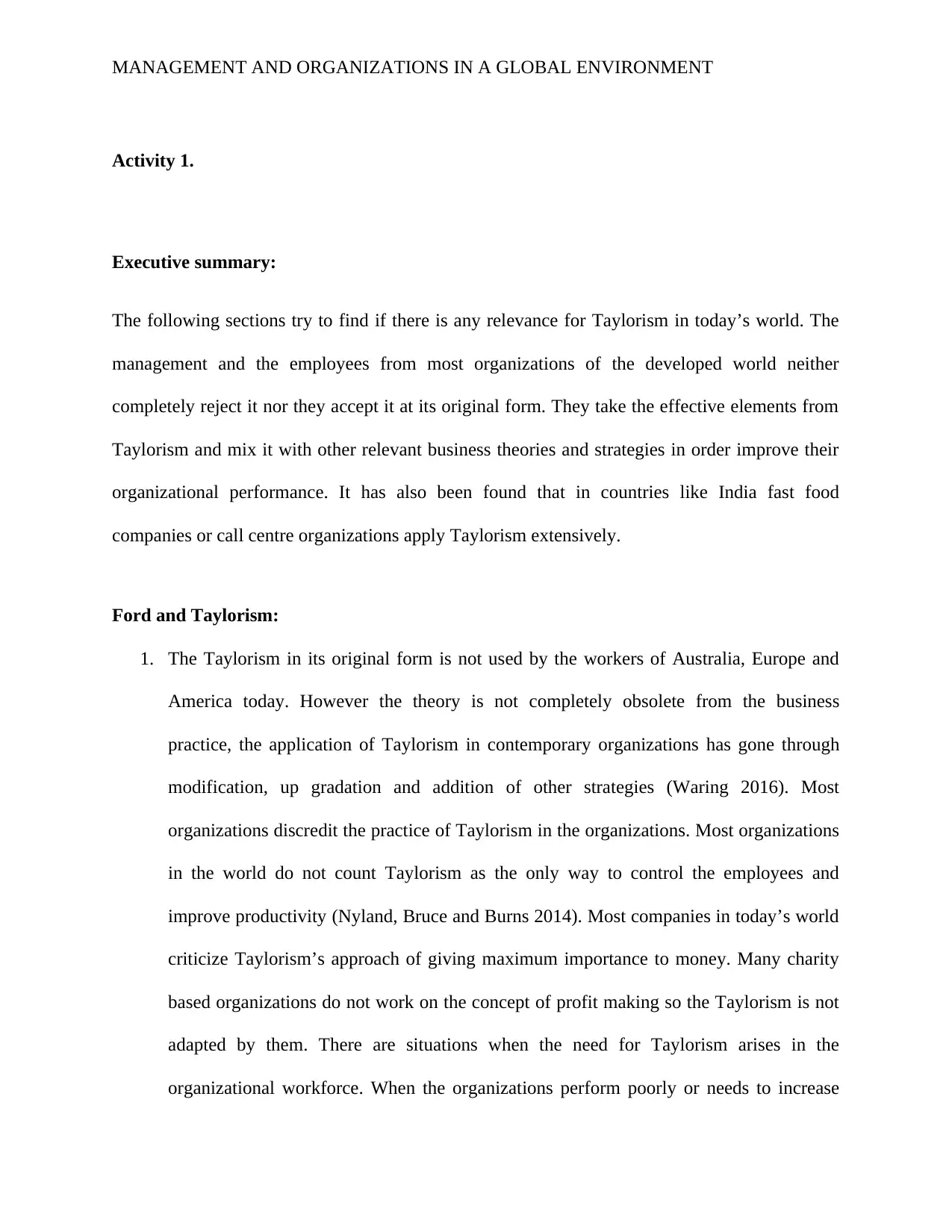
MANAGEMENT AND ORGANIZATIONS IN A GLOBAL ENVIRONMENT
Activity 1.
Executive summary:
The following sections try to find if there is any relevance for Taylorism in today’s world. The
management and the employees from most organizations of the developed world neither
completely reject it nor they accept it at its original form. They take the effective elements from
Taylorism and mix it with other relevant business theories and strategies in order improve their
organizational performance. It has also been found that in countries like India fast food
companies or call centre organizations apply Taylorism extensively.
Ford and Taylorism:
1. The Taylorism in its original form is not used by the workers of Australia, Europe and
America today. However the theory is not completely obsolete from the business
practice, the application of Taylorism in contemporary organizations has gone through
modification, up gradation and addition of other strategies (Waring 2016). Most
organizations discredit the practice of Taylorism in the organizations. Most organizations
in the world do not count Taylorism as the only way to control the employees and
improve productivity (Nyland, Bruce and Burns 2014). Most companies in today’s world
criticize Taylorism’s approach of giving maximum importance to money. Many charity
based organizations do not work on the concept of profit making so the Taylorism is not
adapted by them. There are situations when the need for Taylorism arises in the
organizational workforce. When the organizations perform poorly or needs to increase
Activity 1.
Executive summary:
The following sections try to find if there is any relevance for Taylorism in today’s world. The
management and the employees from most organizations of the developed world neither
completely reject it nor they accept it at its original form. They take the effective elements from
Taylorism and mix it with other relevant business theories and strategies in order improve their
organizational performance. It has also been found that in countries like India fast food
companies or call centre organizations apply Taylorism extensively.
Ford and Taylorism:
1. The Taylorism in its original form is not used by the workers of Australia, Europe and
America today. However the theory is not completely obsolete from the business
practice, the application of Taylorism in contemporary organizations has gone through
modification, up gradation and addition of other strategies (Waring 2016). Most
organizations discredit the practice of Taylorism in the organizations. Most organizations
in the world do not count Taylorism as the only way to control the employees and
improve productivity (Nyland, Bruce and Burns 2014). Most companies in today’s world
criticize Taylorism’s approach of giving maximum importance to money. Many charity
based organizations do not work on the concept of profit making so the Taylorism is not
adapted by them. There are situations when the need for Taylorism arises in the
organizational workforce. When the organizations perform poorly or needs to increase
⊘ This is a preview!⊘
Do you want full access?
Subscribe today to unlock all pages.

Trusted by 1+ million students worldwide
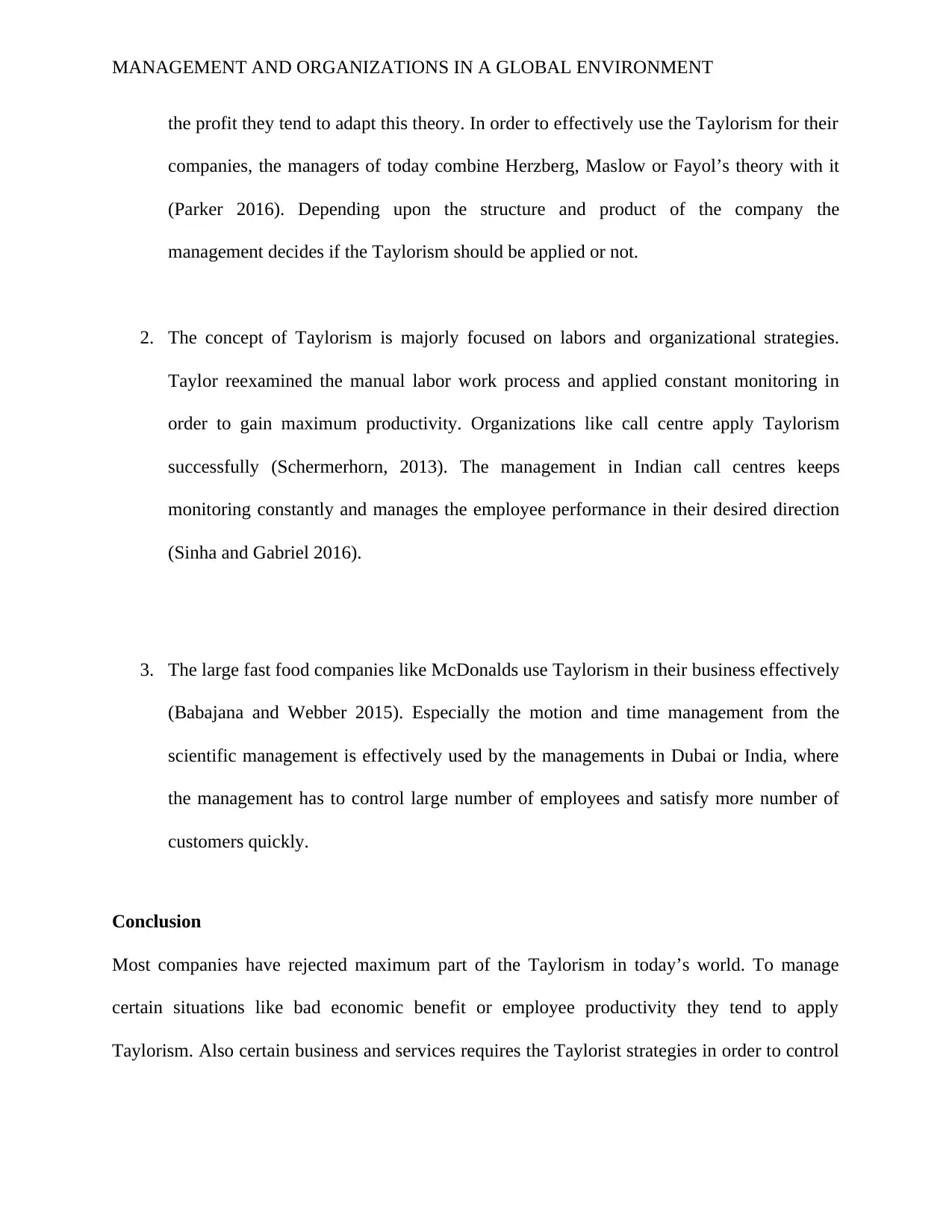
MANAGEMENT AND ORGANIZATIONS IN A GLOBAL ENVIRONMENT
the profit they tend to adapt this theory. In order to effectively use the Taylorism for their
companies, the managers of today combine Herzberg, Maslow or Fayol’s theory with it
(Parker 2016). Depending upon the structure and product of the company the
management decides if the Taylorism should be applied or not.
2. The concept of Taylorism is majorly focused on labors and organizational strategies.
Taylor reexamined the manual labor work process and applied constant monitoring in
order to gain maximum productivity. Organizations like call centre apply Taylorism
successfully (Schermerhorn, 2013). The management in Indian call centres keeps
monitoring constantly and manages the employee performance in their desired direction
(Sinha and Gabriel 2016).
3. The large fast food companies like McDonalds use Taylorism in their business effectively
(Babajana and Webber 2015). Especially the motion and time management from the
scientific management is effectively used by the managements in Dubai or India, where
the management has to control large number of employees and satisfy more number of
customers quickly.
Conclusion
Most companies have rejected maximum part of the Taylorism in today’s world. To manage
certain situations like bad economic benefit or employee productivity they tend to apply
Taylorism. Also certain business and services requires the Taylorist strategies in order to control
the profit they tend to adapt this theory. In order to effectively use the Taylorism for their
companies, the managers of today combine Herzberg, Maslow or Fayol’s theory with it
(Parker 2016). Depending upon the structure and product of the company the
management decides if the Taylorism should be applied or not.
2. The concept of Taylorism is majorly focused on labors and organizational strategies.
Taylor reexamined the manual labor work process and applied constant monitoring in
order to gain maximum productivity. Organizations like call centre apply Taylorism
successfully (Schermerhorn, 2013). The management in Indian call centres keeps
monitoring constantly and manages the employee performance in their desired direction
(Sinha and Gabriel 2016).
3. The large fast food companies like McDonalds use Taylorism in their business effectively
(Babajana and Webber 2015). Especially the motion and time management from the
scientific management is effectively used by the managements in Dubai or India, where
the management has to control large number of employees and satisfy more number of
customers quickly.
Conclusion
Most companies have rejected maximum part of the Taylorism in today’s world. To manage
certain situations like bad economic benefit or employee productivity they tend to apply
Taylorism. Also certain business and services requires the Taylorist strategies in order to control
Paraphrase This Document
Need a fresh take? Get an instant paraphrase of this document with our AI Paraphraser
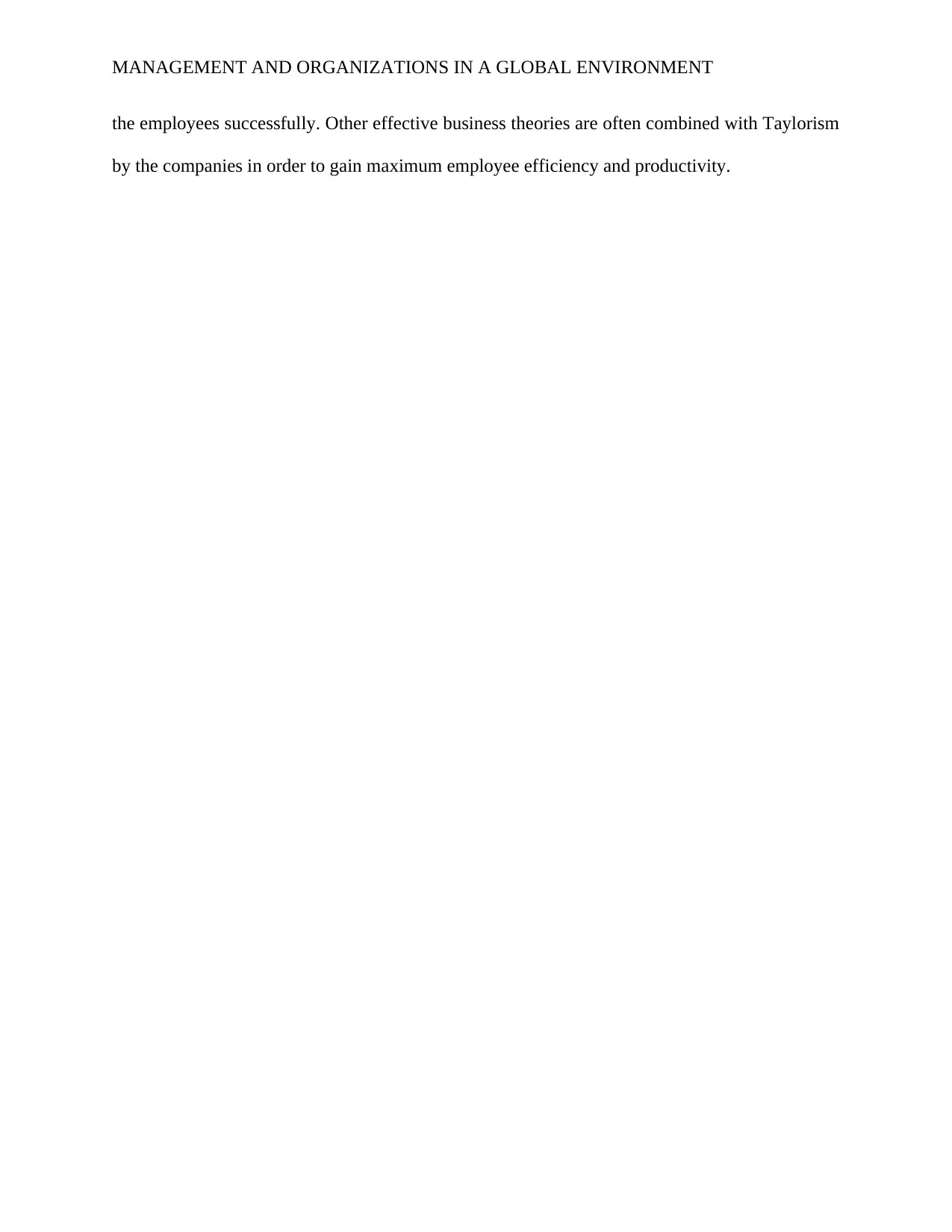
MANAGEMENT AND ORGANIZATIONS IN A GLOBAL ENVIRONMENT
the employees successfully. Other effective business theories are often combined with Taylorism
by the companies in order to gain maximum employee efficiency and productivity.
the employees successfully. Other effective business theories are often combined with Taylorism
by the companies in order to gain maximum employee efficiency and productivity.
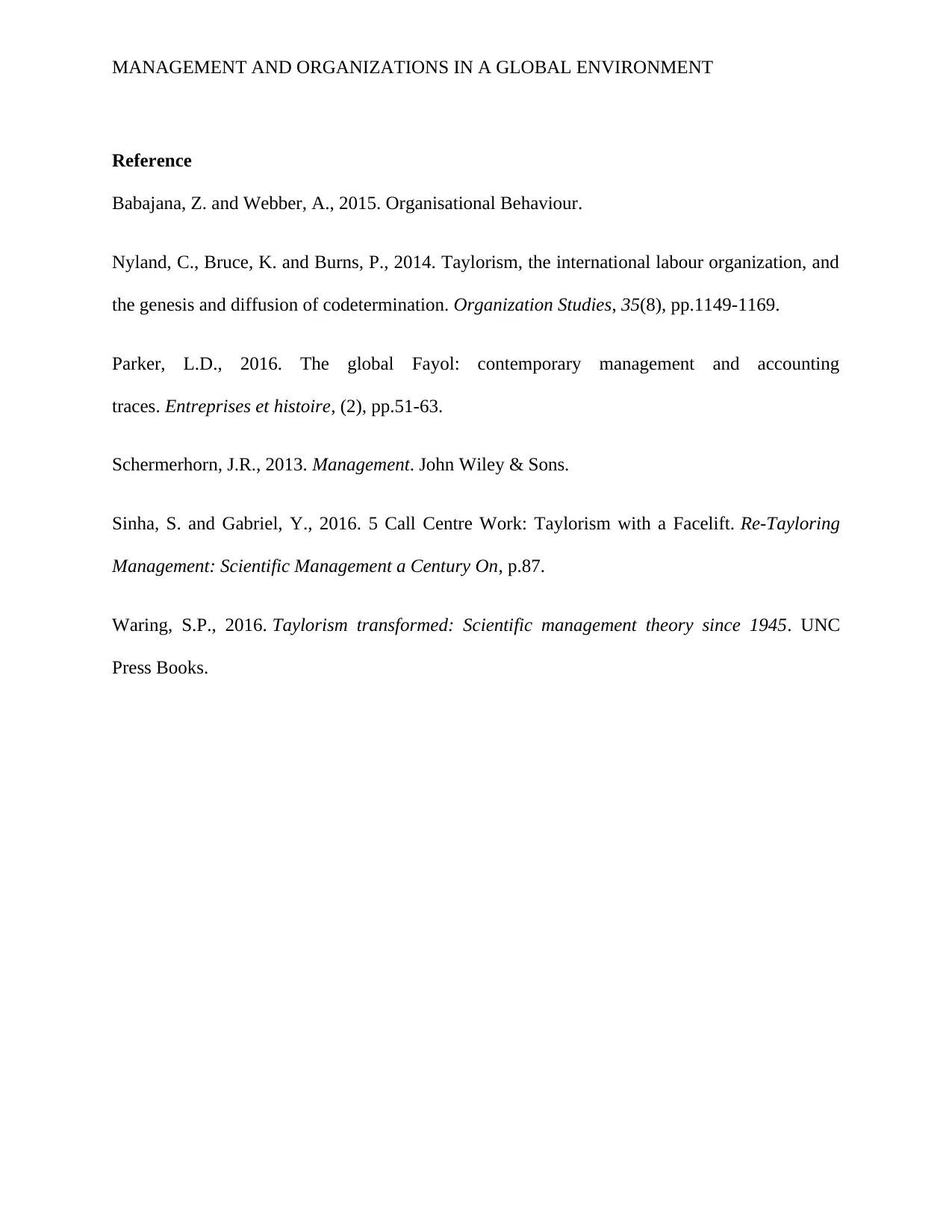
MANAGEMENT AND ORGANIZATIONS IN A GLOBAL ENVIRONMENT
Reference
Babajana, Z. and Webber, A., 2015. Organisational Behaviour.
Nyland, C., Bruce, K. and Burns, P., 2014. Taylorism, the international labour organization, and
the genesis and diffusion of codetermination. Organization Studies, 35(8), pp.1149-1169.
Parker, L.D., 2016. The global Fayol: contemporary management and accounting
traces. Entreprises et histoire, (2), pp.51-63.
Schermerhorn, J.R., 2013. Management. John Wiley & Sons.
Sinha, S. and Gabriel, Y., 2016. 5 Call Centre Work: Taylorism with a Facelift. Re-Tayloring
Management: Scientific Management a Century On, p.87.
Waring, S.P., 2016. Taylorism transformed: Scientific management theory since 1945. UNC
Press Books.
Reference
Babajana, Z. and Webber, A., 2015. Organisational Behaviour.
Nyland, C., Bruce, K. and Burns, P., 2014. Taylorism, the international labour organization, and
the genesis and diffusion of codetermination. Organization Studies, 35(8), pp.1149-1169.
Parker, L.D., 2016. The global Fayol: contemporary management and accounting
traces. Entreprises et histoire, (2), pp.51-63.
Schermerhorn, J.R., 2013. Management. John Wiley & Sons.
Sinha, S. and Gabriel, Y., 2016. 5 Call Centre Work: Taylorism with a Facelift. Re-Tayloring
Management: Scientific Management a Century On, p.87.
Waring, S.P., 2016. Taylorism transformed: Scientific management theory since 1945. UNC
Press Books.
⊘ This is a preview!⊘
Do you want full access?
Subscribe today to unlock all pages.

Trusted by 1+ million students worldwide
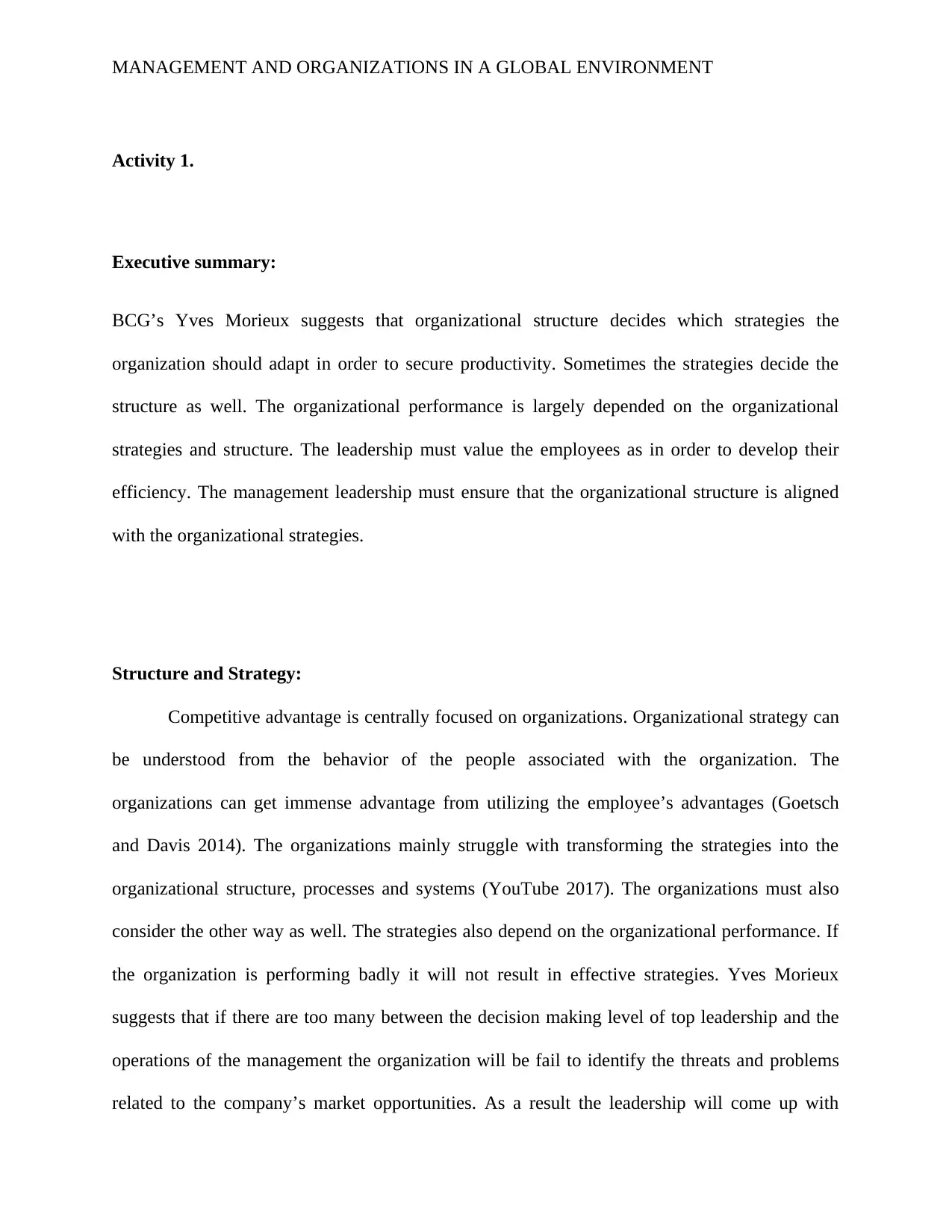
MANAGEMENT AND ORGANIZATIONS IN A GLOBAL ENVIRONMENT
Activity 1.
Executive summary:
BCG’s Yves Morieux suggests that organizational structure decides which strategies the
organization should adapt in order to secure productivity. Sometimes the strategies decide the
structure as well. The organizational performance is largely depended on the organizational
strategies and structure. The leadership must value the employees as in order to develop their
efficiency. The management leadership must ensure that the organizational structure is aligned
with the organizational strategies.
Structure and Strategy:
Competitive advantage is centrally focused on organizations. Organizational strategy can
be understood from the behavior of the people associated with the organization. The
organizations can get immense advantage from utilizing the employee’s advantages (Goetsch
and Davis 2014). The organizations mainly struggle with transforming the strategies into the
organizational structure, processes and systems (YouTube 2017). The organizations must also
consider the other way as well. The strategies also depend on the organizational performance. If
the organization is performing badly it will not result in effective strategies. Yves Morieux
suggests that if there are too many between the decision making level of top leadership and the
operations of the management the organization will be fail to identify the threats and problems
related to the company’s market opportunities. As a result the leadership will come up with
Activity 1.
Executive summary:
BCG’s Yves Morieux suggests that organizational structure decides which strategies the
organization should adapt in order to secure productivity. Sometimes the strategies decide the
structure as well. The organizational performance is largely depended on the organizational
strategies and structure. The leadership must value the employees as in order to develop their
efficiency. The management leadership must ensure that the organizational structure is aligned
with the organizational strategies.
Structure and Strategy:
Competitive advantage is centrally focused on organizations. Organizational strategy can
be understood from the behavior of the people associated with the organization. The
organizations can get immense advantage from utilizing the employee’s advantages (Goetsch
and Davis 2014). The organizations mainly struggle with transforming the strategies into the
organizational structure, processes and systems (YouTube 2017). The organizations must also
consider the other way as well. The strategies also depend on the organizational performance. If
the organization is performing badly it will not result in effective strategies. Yves Morieux
suggests that if there are too many between the decision making level of top leadership and the
operations of the management the organization will be fail to identify the threats and problems
related to the company’s market opportunities. As a result the leadership will come up with
Paraphrase This Document
Need a fresh take? Get an instant paraphrase of this document with our AI Paraphraser
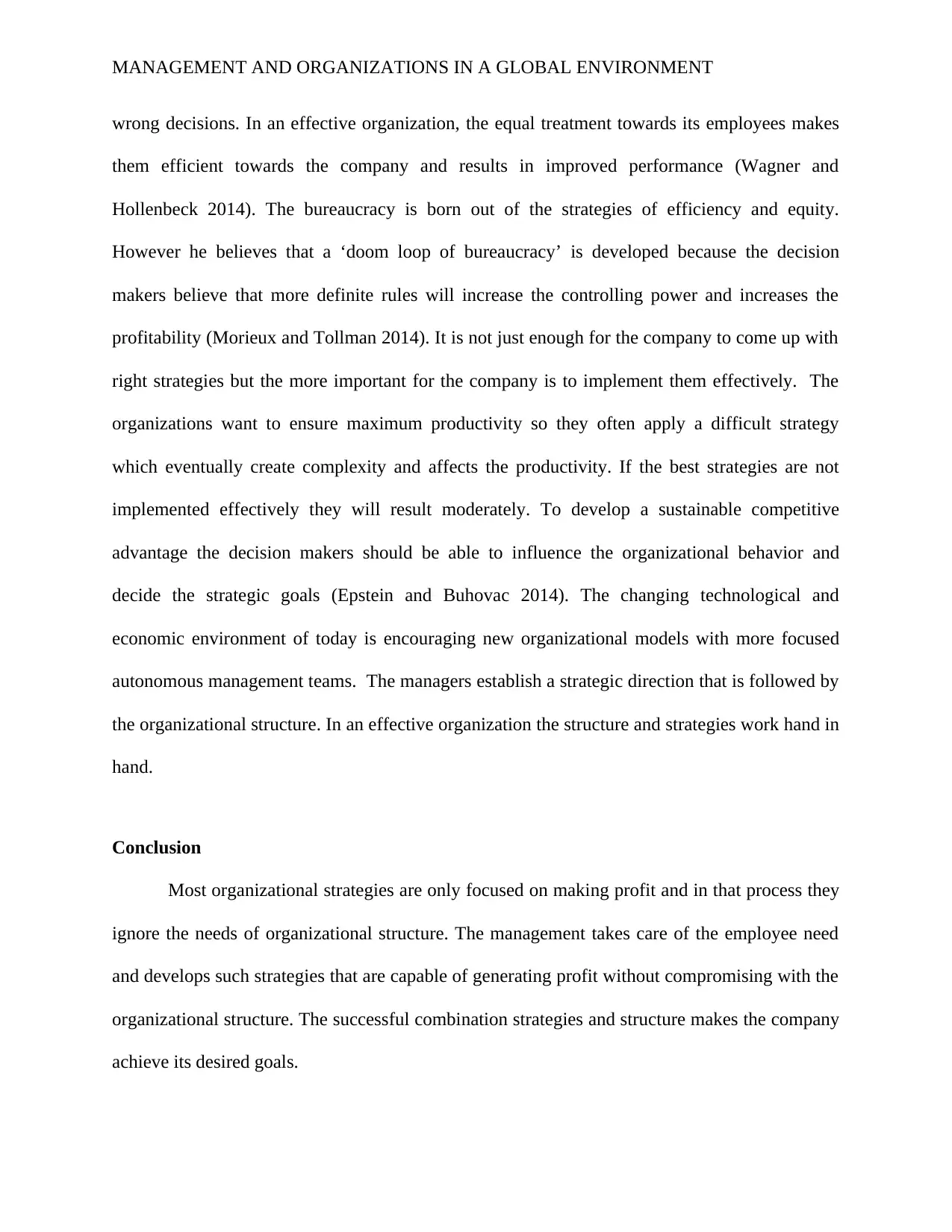
MANAGEMENT AND ORGANIZATIONS IN A GLOBAL ENVIRONMENT
wrong decisions. In an effective organization, the equal treatment towards its employees makes
them efficient towards the company and results in improved performance (Wagner and
Hollenbeck 2014). The bureaucracy is born out of the strategies of efficiency and equity.
However he believes that a ‘doom loop of bureaucracy’ is developed because the decision
makers believe that more definite rules will increase the controlling power and increases the
profitability (Morieux and Tollman 2014). It is not just enough for the company to come up with
right strategies but the more important for the company is to implement them effectively. The
organizations want to ensure maximum productivity so they often apply a difficult strategy
which eventually create complexity and affects the productivity. If the best strategies are not
implemented effectively they will result moderately. To develop a sustainable competitive
advantage the decision makers should be able to influence the organizational behavior and
decide the strategic goals (Epstein and Buhovac 2014). The changing technological and
economic environment of today is encouraging new organizational models with more focused
autonomous management teams. The managers establish a strategic direction that is followed by
the organizational structure. In an effective organization the structure and strategies work hand in
hand.
Conclusion
Most organizational strategies are only focused on making profit and in that process they
ignore the needs of organizational structure. The management takes care of the employee need
and develops such strategies that are capable of generating profit without compromising with the
organizational structure. The successful combination strategies and structure makes the company
achieve its desired goals.
wrong decisions. In an effective organization, the equal treatment towards its employees makes
them efficient towards the company and results in improved performance (Wagner and
Hollenbeck 2014). The bureaucracy is born out of the strategies of efficiency and equity.
However he believes that a ‘doom loop of bureaucracy’ is developed because the decision
makers believe that more definite rules will increase the controlling power and increases the
profitability (Morieux and Tollman 2014). It is not just enough for the company to come up with
right strategies but the more important for the company is to implement them effectively. The
organizations want to ensure maximum productivity so they often apply a difficult strategy
which eventually create complexity and affects the productivity. If the best strategies are not
implemented effectively they will result moderately. To develop a sustainable competitive
advantage the decision makers should be able to influence the organizational behavior and
decide the strategic goals (Epstein and Buhovac 2014). The changing technological and
economic environment of today is encouraging new organizational models with more focused
autonomous management teams. The managers establish a strategic direction that is followed by
the organizational structure. In an effective organization the structure and strategies work hand in
hand.
Conclusion
Most organizational strategies are only focused on making profit and in that process they
ignore the needs of organizational structure. The management takes care of the employee need
and develops such strategies that are capable of generating profit without compromising with the
organizational structure. The successful combination strategies and structure makes the company
achieve its desired goals.
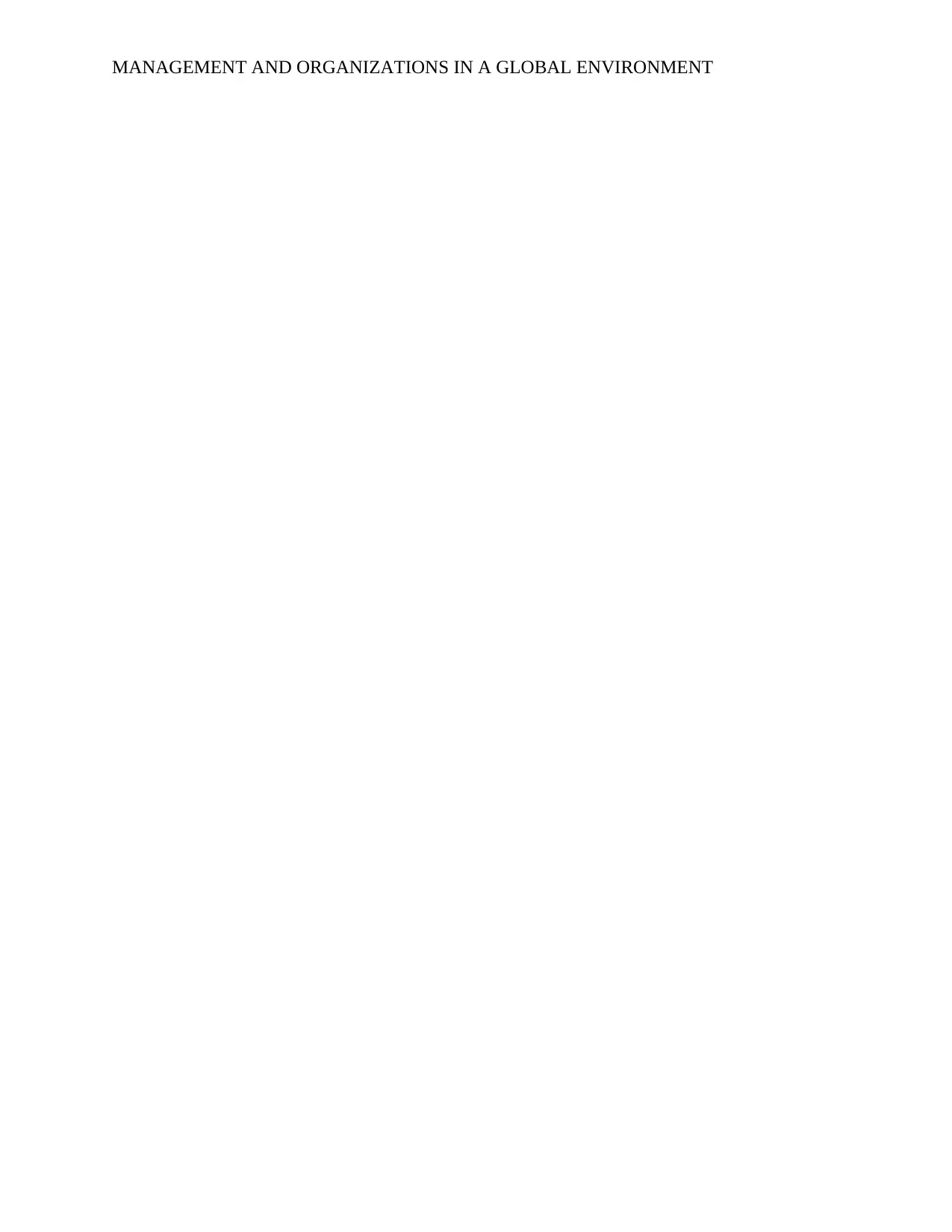
MANAGEMENT AND ORGANIZATIONS IN A GLOBAL ENVIRONMENT
⊘ This is a preview!⊘
Do you want full access?
Subscribe today to unlock all pages.

Trusted by 1+ million students worldwide
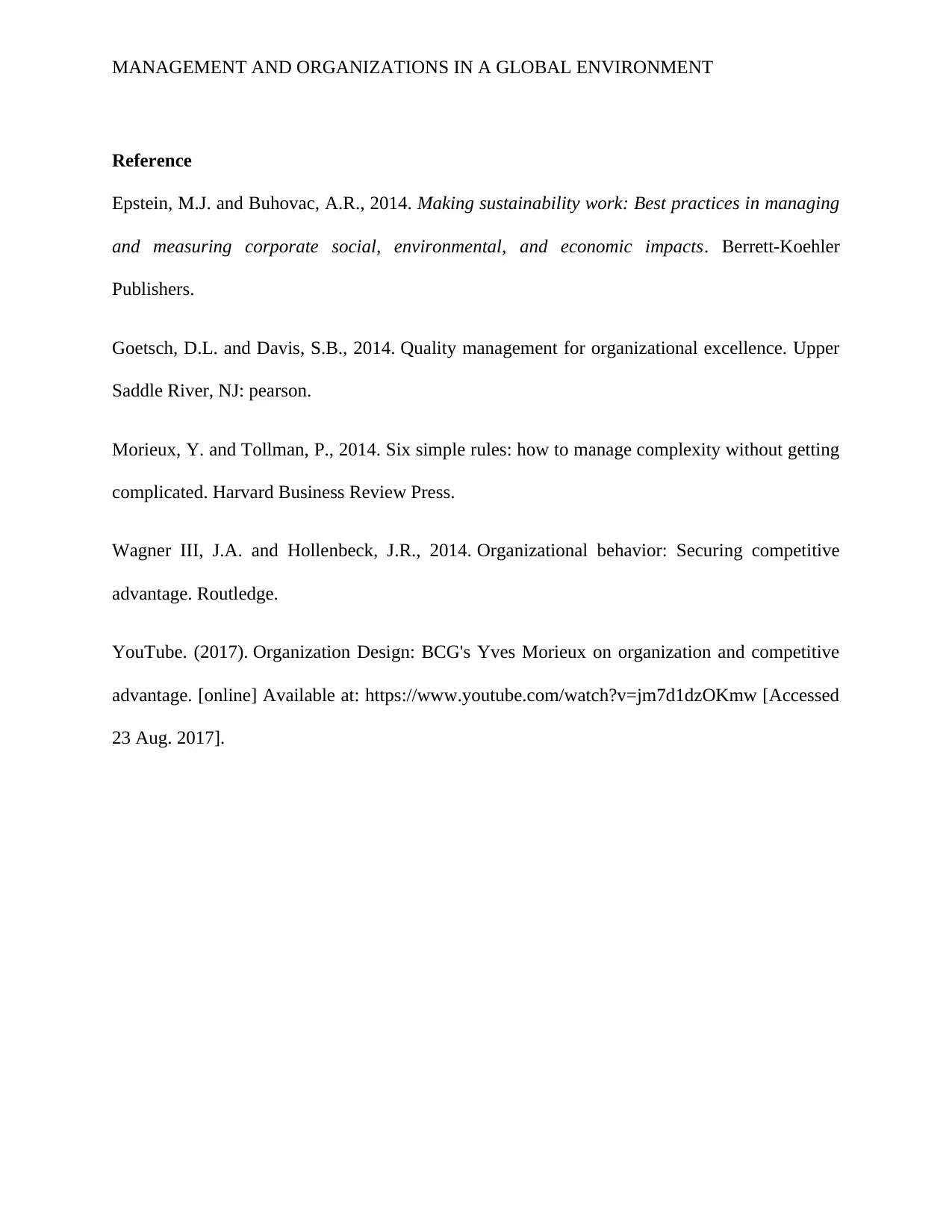
MANAGEMENT AND ORGANIZATIONS IN A GLOBAL ENVIRONMENT
Reference
Epstein, M.J. and Buhovac, A.R., 2014. Making sustainability work: Best practices in managing
and measuring corporate social, environmental, and economic impacts. Berrett-Koehler
Publishers.
Goetsch, D.L. and Davis, S.B., 2014. Quality management for organizational excellence. Upper
Saddle River, NJ: pearson.
Morieux, Y. and Tollman, P., 2014. Six simple rules: how to manage complexity without getting
complicated. Harvard Business Review Press.
Wagner III, J.A. and Hollenbeck, J.R., 2014. Organizational behavior: Securing competitive
advantage. Routledge.
YouTube. (2017). Organization Design: BCG's Yves Morieux on organization and competitive
advantage. [online] Available at: https://www.youtube.com/watch?v=jm7d1dzOKmw [Accessed
23 Aug. 2017].
Reference
Epstein, M.J. and Buhovac, A.R., 2014. Making sustainability work: Best practices in managing
and measuring corporate social, environmental, and economic impacts. Berrett-Koehler
Publishers.
Goetsch, D.L. and Davis, S.B., 2014. Quality management for organizational excellence. Upper
Saddle River, NJ: pearson.
Morieux, Y. and Tollman, P., 2014. Six simple rules: how to manage complexity without getting
complicated. Harvard Business Review Press.
Wagner III, J.A. and Hollenbeck, J.R., 2014. Organizational behavior: Securing competitive
advantage. Routledge.
YouTube. (2017). Organization Design: BCG's Yves Morieux on organization and competitive
advantage. [online] Available at: https://www.youtube.com/watch?v=jm7d1dzOKmw [Accessed
23 Aug. 2017].
1 out of 10
Related Documents
Your All-in-One AI-Powered Toolkit for Academic Success.
+13062052269
info@desklib.com
Available 24*7 on WhatsApp / Email
![[object Object]](/_next/static/media/star-bottom.7253800d.svg)
Unlock your academic potential
Copyright © 2020–2025 A2Z Services. All Rights Reserved. Developed and managed by ZUCOL.




